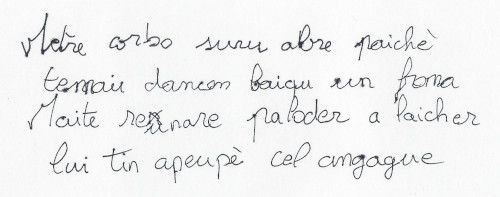
Dyslexia, dysgraphia and dysorthography are caused by the same neurological disorder resulting in a cognitive deficit that translates into difficulties in reading in the first case, and in writing in the second. If a child is dyslexic as a result, the chances are high that he or she is also dysorthographic. And the reverse is also possible, a predominantly dysorthographic child may also suffer from dyslexia.
Dyslexia is rarely an isolated disorder. It is almost always accompanied by more or less severe writing and spelling disorders. The reason is simple: when a person has difficulty at the grapheme level, that is, when she cannot recognize or understand the words she sees, she may also have great difficulty memorizing them. The logical result is that she cannot write them either.
Under these conditions, we can consider dysorthographia as a progressive form of dyslexia. This explains why these two disorders are often associated and why, among learning difficulties, dyslexic disorder is considered one of the most disabling.
Dyslexia as a component of dysorthographia A child who cannot spell words correctly may also have difficulty reading them, but this does not have to be the case. Unlike dyslexia, dysorthography can be very well isolated. In other words, a child can be dysorthographic and not have dyslexia! Under these conditions, dyslexia can be considered as simply a possible component of dysorthography or as its logical consequence.
What is dysgraphia Writing is a fine motor activity. Its mastery, long and complex, requires the acquisition of automatisms. In dysgraphia, despite the repetition of exercises, gestures are not automated. Dysgraphia affects 10% of children and is observed especially in boys. It manifests itself in several ways:
– Malformation of letters due to the inability of the fingers to control a pen.
– Difficulty in integrating writing automatisms.
How does dysorthography manifest itself?
Dysorthographia is the manifestation of a persistent difficulty in the acquisition and assimilation of spelling rules.
It’s often associated with dyslexia because language learning disorders are present in both writing and reading. The young child with dysorthography is slow and has difficulty during both dictation and spontaneous writing.
We can list at least four types of dyslexia-dysorthographia:
– Dysphonemic dyslexia-dysgraphia-dysgraphia
– Dyslexia-dysgraphia dysgraphia-dysgraphia dysgraphia
– Mixed dyslexia-dysgraphia-dysgraphia
– Visuo-attentional dyslexia-dyslexia-dysorthographia
This is the most common form of dyslexia-dysgraphia.
As its name suggests, it is characterized by a deficiency in the phonological pathway that results in significant gaps in the conversion rules.
That is, the child who suffers from it is unable or has great difficulty in recognizing and identifying the sounds he or she hears.
This leads to both written and oral:
– Prescription errors characterized by inversion,addition, omission of graphemes;
– Confusion of sonority or graphemes that are visually or graphically close;
– Problems with the structuring of written productions;
– Difficulties in transcribing non-words;
– Misunderstanding or misapplication of known grammatical or orthographic rules.
This form of dyslexia, less frequent than the previous one, is characterized by reading and spelling problems despite good phonological ability. The deficit is actually caused by a deficiency in the lexical pathway leading to a disturbance of access to meaning as well as perception.
Thus, the affected child has no difficulty with phoneme/grapheme correspondence. He is able to decode regular words and even non-words, however, he presents:
– Poor spelling due to a particularly weak visual lexicon: he is not able to memorize the way words he is supposed to know are spelled.
An inability to segment due to misunderstandings or lack of comprehension of what is written.
In other words, the child is content to read or write what he sees, without really understanding any meaning. Visual memorization suddenly becomes impossible.
– Mixed dyslexia-dysorthographia
Dyslexia and mixed dysorthographia combine the above two forms of learning disabilities. Which is in fact a formidable handicap characterized by:
– Impairment of the phonological pathway, which subsequently leads to – – – Impairment in visual memorization;
– Impairment of the lexical pathway, which subsequently leads to an – – — — Impairment in perceptual discrimination.
In the affected child, this particular form of learning difficulty is manifested by: Significant difficulties in phonemic-graphemic encoding and decoding;
– Extreme orthographic and grammatical poverty of use;
– A deficiency in reading comprehension;
– A high frequency of segmentation failures.
Visuo-attentional dyslexia-dysgraphia is rarely mentioned by specialists, much less in books dealing with dyslexia and dysorthography, but it exists nonetheless!
This type of learning difficulty is not due to a phonological deficiency or a lexical disability. As the name suggests, this form of dyslexia-dysorthographia is the consequence of a deficit at the viso-attentional level which would make the exploitation of phonological and lexical skills ineffective. The « attentional » component also plays an essential role in the development of learning to read and write because the child is unable to classify relevant information and focus his attention on it. He is then easily disturbed by distracting factors.
This results in:
– Extinctions of reformulations;
– Persistent spelling and lexical poverty;
– A tendency to add, omit, reverse phonemes and words;
– A tendency to confuse phonologically similar sounds;
– A tendency to confuse morphologically close graphemes;
– A tendency to skip lines; Limited comprehension;
– Poor quality writing;
– Extentions of phonemes, syllables, words.
« The Dys children are intelligent children who suffer from not being able to show or prove it. their ability to learn is different, their will is the same ».
Olivier REVOL